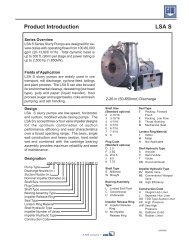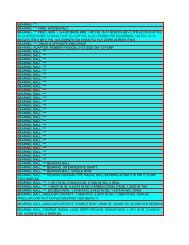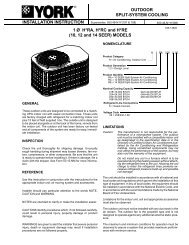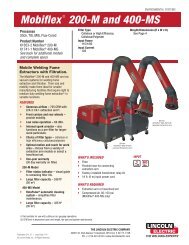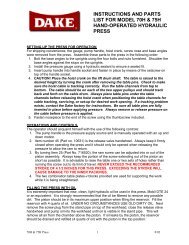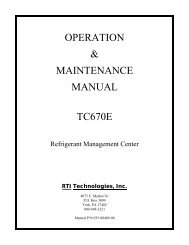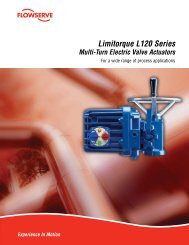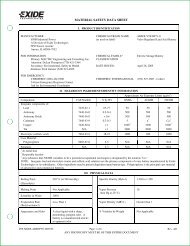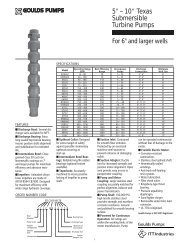Download Operating Manual - NY Tech Supply
Download Operating Manual - NY Tech Supply
Download Operating Manual - NY Tech Supply
You also want an ePaper? Increase the reach of your titles
YUMPU automatically turns print PDFs into web optimized ePapers that Google loves.
LISTED<br />
80S2<br />
Recycling Equipment Design<br />
Certified by Underwriters<br />
Laboratories Inc.,® for<br />
Compliance with SAE-J2210<br />
(1991) for HFC-134a and<br />
SAE-J1991 (1989) for CFC-12<br />
Refrigerant Recovery,<br />
Recycling and Recharging Station<br />
Series: 17700A/17701A<br />
and 34700/34701/34704<br />
Refrigerants: R-12 (17700A/17701A)<br />
or R-134a (34700/34701)<br />
WARNING<br />
PRESSURIZED TANK CONTAINS LIQUID REFRIGERANT. OVERFILLING OF THE TANK MAY CAUSE VIOLENT<br />
EXPLOSION AND POSSIBLE INJURY OR DEATH. Safety devices require the use of only authorized refillable refrigerant<br />
tanks. Refer to the instruction manual for tank specifications and ordering information. Do not recover refrigerants<br />
into a non-refillable storage container! Federal regulations require refrigerant to be transported only in containers meeting<br />
DOT spec. 4BW or DOT spec. 4BA.<br />
ALL HOSES MAY CONTAIN LIQUID REFRIGERANT UNDER PRESSURE. Contact with refrigerant may cause injury.<br />
Wear proper protective equipment, including safety goggles. Disconnect hoses with extreme caution.<br />
HIGH VOLTAGE ELECTRICITY INSIDE PANELS. RISK OF ELECTRICAL SHOCK. Disconnect power before servicing<br />
unit. Refer to the instruction manual.<br />
TO REDUCE THE RISK OF FIRE, avoid the use of an extension cord because the<br />
extension cord may overheat. However, if you must use an extension cord, use No. 14 AWG at the minimum and as<br />
short as possible. Do not use this equipment in the vicinity of spilled or open containers of gasoline or other flammable<br />
substances.<br />
Use this equipment in locations with mechanical ventilation that provides at least four air changes per hour or locate the<br />
equipment at least 18 inches above the floor.<br />
Make certain that all safety devices are functioning properly before operating the unit. Before operating, read and follow<br />
the instructions and warnings in the manual.<br />
CAUTION: SHOULD BE OPERATED BY QUALIFIED PERSONNEL. Operator must be familiar with air conditioning<br />
and refrigeration systems, refrigerants and the dangers of pressurized components.<br />
Use only with R-12 (17700A/17701A) or R-134a (34700/34701). This equipment is not designed for any other<br />
purpose than recovering, recycling or recharging refrigerants! Do not mix refrigerant types!<br />
ATTENTION!<br />
Ce réservoir sous pression contient du frigorigène liquide. S’il est surchargé, ce réservoir peut exploser et causer des<br />
blessures ou la mort.<br />
ATTENTION. Débrancher avant la maintenance.<br />
ATTENTION. Pour réduire les risques d’incendie, ne pas utiliser de cordon prolongateur de section inférieure à 14 AWG<br />
de facon à éviter la surchauffe du cordon.<br />
ATTENTION. Utiliser seulement du frigorigène R-12 (17700A/17701A) ou R-134a (34700/34701).<br />
OPERATING NOTES<br />
At temperatures exceeding 120 o F / 49 o C, wait 10 minutes between recovery jobs.<br />
R-134a WARNINGS!<br />
Use the Series 34700/34701 only with R-134a! Cross-contamination with other refrigerant types will cause severe<br />
damage to the A/C system and to service tools and equipment. Do not mix refrigerant types through a system or in the<br />
same container!<br />
Avoid breathing A/C refrigerant and lubricant vapor or mist. Exposure may irritate eyes, nose and throat. To remove<br />
R-134a from the A/C system, use service equipment certified to meet the requirements of SAE-J2210 (R-134a recycling<br />
equipment). If accidental system discharge occurs, ventilate work area before resuming service.<br />
HFC-134a service equipment or vehicle A/C systems should not be pressure tested or leak tested with compressed air.<br />
Some mixtures of air/HFC-134a have been shown to be combustible at elevated pressures. These mixtures are potentially<br />
dangerous and may result in fire or explosion causing injury or property damage.<br />
Additional health and safety information may be obtained from refrigerant and lubricant manufacturers.



